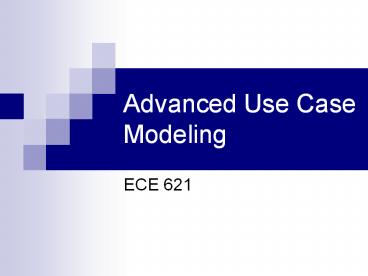Advanced Use Case Modeling - PowerPoint PPT Presentation
Title:
Advanced Use Case Modeling
Description:
Advanced Use Case Modeling ECE 621 Association Relationship Association Relation Example Abstract Use Case Abstract use cases cannot be performed Abstract use cases ... – PowerPoint PPT presentation
Number of Views:245
Avg rating:3.0/5.0
Title: Advanced Use Case Modeling
1
Advanced Use Case Modeling
- ECE 621
2
Association Relationship
- Association relationships only show which actors
interact with the system to perform a given use
case - Association relationship DO NOT model the flow of
data between the actor and the system - A directed association relationship only shows if
the system or the actor initiates the connection
3
Association Relation Example
4
Abstract Use Case
- Abstract use cases cannot be performed
- Abstract use cases only provide partial behavior
and thus they need to be implemented
5
Generalization Relationship
- Child use case provides a specialized version of
the behavior in the parent use case. - The generalization relationship are used to
implement an abstract
6
Generalization Relationship 2
- The Buy Tickets use case is concrete because it
can be performed all by itself
7
Include Relationship
- Include relationship are used to model behavior
repetition or reuse
8
Extend Relationship
- Extension use cases usually contain behavior that
it optional or exceptional - Extension use cases are usually performed upon a
condition being satisfied
9
Extension Points
- Extension points state where the behavior in the
extension use case is inserted into the base use
case.
10
Use Case Descriptions
- Usually is used in a template
- There must be one use case description for every
use case shown in the diagram - There must be one actor description for every
actor shown in the diagram
11
Sample Template
Use Case Name
Preconditions Things that must be satisfied first
Basic Flow normal scenario
Alternative Flows slight deviations
Sub Flows repetitive behavior
Exception Points where will the extension behavior be inserted
Postconditions things that must be satisfied before leaving
Special Requirements
12
Buy Tickets Basic Flow
The system displays to the customer a calendar
for all season games. The Customer then chooses
the game he/she would like to attend. The
Customer then specifies the section in which
he/she would like the tickets to be located. The
System checks whether the requested tickets are
available or not. If they are available, the
System offers these tickets to the Customer. The
Customer chooses to accept or reject the tickets.
If the Customer accepts the tickets, the Customer
is offered the option to pay either by a credit
card or using the hockey team card. Upon,
verification of payment information, the tickets
are issued.
13
Buy Tickets - Alternative Flows
- If the System cannot find the required seats,
then Customer is notified and the use case ends - If the Customer rejects the offered tickets, the
use case ends - If the Customers payment information cannot be
verified, the Customer is notified to contact
customer service and then the use case ends
14
Buy Ticket - Subflows
- After the Customer enters the information
regarding the requested seats the system the
systems first checks to see if there are any
tickets in the given section then the system
checks if there are any consecutive seats as
there is the required number of tickets.
15
Buy Team Merchandise Extension Points
- Extension Points
- Whenever team merchandise is purchased and a
ticket is entered for a chance to win































